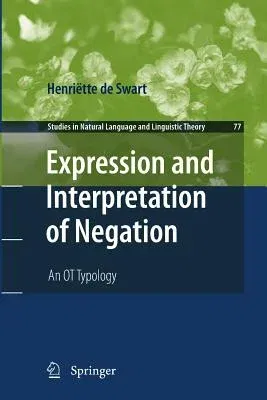Preface.- 1. Negation in a cross-linguistic perspective.1.0 Introduction
and overview.1.1 Negation in logic and language.1.2 Negation in typology
and diachronic linguistics.1.3. Negative polarity.1.4 Negative concord:
observations and issues.1.5 A polyadic quantifier analysis of double
negation and negative concord.1.6 Negation and negative indefinites.1.7
Outline of the book.- 2. Expressive and interpretive optimization. 2.0
Introduction and overview. 2.1 Fundamentals of OT as a model of grammar.
2.2 Fundamentals of OT syntax. 2.3 Fundamentals of OT semantics.2.4
Bidirectional Optimality Theory.2.5 Language variation and language
change in stochastic OT.2.6 Conclusion.- 3. Markedness of negation.3.0
Introduction and overview.3.1 Propositional negation.3.2 Negation in
users of sign language who have suffered brain damage.3.3 Typological
variation in the placement of negation.3.4 A dynamic analysis of the
Jespersen cycle.3.5 Subordinate clauses and non-finite constructions.3.6
Conclusion.- 4. A typology of negative indefinites.4.0 Introduction and
overview.4.1 Negative attraction.4.2 Multiple indefinites under
negation: an empirical classification.4.3 Double negation and negative
concord as instances of polyadic quantification.4.3.1 Iteration and
resumption.4.4 Marking and interpretation of negation in strong
bi-directional OT.4.5 Negative concord and negative polarity.4.6
Conclusion.- 5. Sentential negation and negative indefinites. 5.0
Introduction and overview.5.1 Classification of cooccurrence
restrictions.5.2 Towards an analysis.5.3 Preverbal/post-verbal
asymmetry.5.4 Obligatory marker of sentential negation5.5 Mixed
cases.5.6 Two varieties of French.5.7 Negation and negative indefinites
in Welsh.5.8 Negation and negative indefinites in Hungarian.5.9 Flemish:
a puzzle.5.10 Negative doubling and negative spread.5.11 Conclusion.- 6.
More on double negation.6.0 Introduction and overview.6.1 Affixal
negation.6.2 Multiple clause negation.6.3 Ambiguities with multiple
n-words.6.4 DN and NC languages in strong bi-directional OT.6.5 Double
negation in NC languages in weak bi-directional OT.6.6 Conclusion.- 7.
Conclusion and perspectives for further research.7.0 Introduction and
overview.7.1 Summary of research.7.2 Embedding into a broader theory of
cognition.7.3 Perspectives for further research.7.4 Conclusion.-
References.- Index Subjects/Names/Languages


